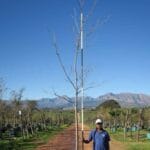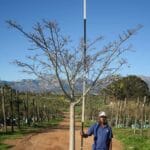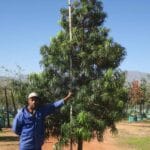Showing 985–996 of 2352 resultsSorted by popularity
- Sale!

Buddleja Saligna 200lt
100-200lt Trees, All Plants, Export, Full Sun Plants, Hedging Plants, Indigenous Plants, Semi Shade Plants, Water Wise PlantsOriginal price was: R6,500.00.R4,500.00Current price is: R4,500.00.Add to cartBuddleja Saligna 200lt
Common Name: False OliveBuddleja saligna, commonly known as the False Olive or White Olive, is a species of flowering shrub or small tree belonging to the Buddlejaceae family. It is native to southern Africa, specifically found in countries such as South Africa, Mozambique, and Zimbabwe.
Appearance: The False Olive is a fast-growing evergreen shrub or small tree that can reach heights of about 5 to 10 meters. It has a dense, rounded canopy and pendulous branches.
Leaves: The leaves are lance-shaped or elongated, measuring around 5-12 cm in length. They are dark green on the upper side and have a silvery or greyish appearance on the lower side.
Flowers: The shrub produces fragrant, small, tubular, creamy-white flowers that are arranged in slender, elongated clusters. These flower clusters can be quite attractive to butterflies and other pollinators.
Fruit: After flowering, Buddleja saligna develops small, woody capsules containing tiny seeds.
Habitat: The False Olive is well-adapted to a variety of habitats, from coastal areas to rocky slopes and open woodlands. It is also common in disturbed areas and can be considered a pioneer species.
Uses: In some regions, Buddleja saligna has been used for various purposes. For example, the wood is occasionally used for furniture, and the leaves and bark have traditional medicinal uses. The plant is also valued for its role in attracting wildlife, particularly butterflies and birds, making it a popular choice in gardens and landscapes for biodiversity and wildlife conservation.
- Sale!

Acacia Galpinii 200lt (Monkey Thorn)
Original price was: R6,500.00.R4,500.00Current price is: R4,500.00.Add to cartAcacia Galpinii 200lt
Common Name: Monkey Thorn - Sale!

Vachellia Xanthophloea 200lt
Original price was: R6,500.00.R4,500.00Current price is: R4,500.00.Add to cartVachellia Xanthophloea 200lt
Common Name: Fever tree (English), Koorsboom, Acacia XanthophloeFull Sun
Medium Watering
Indigenous
Wind TolerantThorn tree that grows up to 12m in height with paper=like bark and a flat spreading crown. They have light yellow flowers in Spring.
- Sale!

Carya illinoinensis (Pecan nut) 200lt Tree
Original price was: R6,500.00.R4,500.00Current price is: R4,500.00.Add to cartCarya illinoinensis (Pecan nut) 200lt
Full Sun
Low Watering
Wind Tolerant - Sale!

Celtis Sinensis 200lt Tree
Original price was: R6,500.00.R4,500.00Current price is: R4,500.00.Add to cartCeltis Sinensis 200lt Tree
Common Name: Chinese HackberryFull Sun
Semi Shade
Medium Watering
Drought Resistant
Deciduous TreeCeltis sinensis is commonly known as Chinese Hackberry and is a species of flowering tree in the Cannabaceae family. It is native to various regions in East Asia, including China, Japan, Korea, and Taiwan. This deciduous tree is known for its adaptability and has been introduced and cultivated in other parts of the world as an ornamental tree.
Appearance: Chinese Hackberry is a medium-sized tree that can grow up to 10-20 meters in height. It has a rounded crown and a moderately spreading canopy. The bark is grey to light brown, and the branches are often covered with corky ridges.
Leaves: The leaves are alternate, simple, and have a serrated or toothed margin. They are typically ovate or elliptical and have a glossy green colour. In the fall, the leaves turn yellow or yellow-green before shedding.
Flowers: The tree produces small, inconspicuous greenish flowers in spring, usually in April or May, depending on the region. The flowers are not showy, but they are an essential food source for pollinators.
Fruits: After flowering, Celtis sinensis develops small, round, berry-like fruits that ripen to a dark purple or black colour. These fruits are often eaten by birds, contributing to seed dispersal.
Habitat: Chinese Hackberry is adaptable to various soil types and can tolerate a range of environmental conditions, including both moist and dry sites. It is commonly found in woodlands, forests, and along riverbanks.
Uses: Celtis sinensis is valued as an ornamental tree in landscapes and urban areas due to its attractive foliage, interesting bark texture, and adaptability to urban conditions. It can be planted as a shade tree, street tree, or in parks and gardens.
- Sale!

Ceratonia Siliqua 200lt
Original price was: R6,500.00.R4,500.00Current price is: R4,500.00.Add to cartCeratonia Siliqua 200lt
Common Name: Carob Tree, Locust TreeFull Sun
Semi Shade
Medium Watering
Drought Resistant
Evergreen TreeCeratonia siliqua, commonly known as the carob tree, is a flowering evergreen tree in the Fabaceae family. It is native to the Mediterranean region, including parts of Southern Europe, Northern Africa, and the Middle East.
Botanical Characteristics
Leaves: The carob tree has compound leaves with 4-10 oval leaflets that are glossy and dark green.
Flowers: The tree produces small, red-tinted flowers that are either male, female, or hermaphroditic.
Fruit: The carob tree is best known for its edible pods, which are long, brown, and leathery. These pods contain a sweet pulp and several hard seeds.Growing Conditions
Climate: Carob trees thrive in warm, dry climates typical of the Mediterranean region. They are drought-tolerant and can grow in poor soils.
Soil: While they prefer well-drained, sandy, or loamy soils, carob trees can also grow in rocky and less fertile soils.
Watering: Carob trees are highly drought-resistant once established, requiring minimal water.Uses
Culinary: The pods are often ground into carob powder, which is used as a cocoa substitute in various recipes, including baked goods, beverages, and confectionery. The seeds are used to produce locust bean gum, a common thickening agent in food products.
Animal Feed: The pods are also used as livestock feed due to their high nutritional content.
Other Uses: The wood of the carob tree is hard and can be used for carpentry, while the leaves and pods have been used in traditional medicine.Nutritional and Health Benefits
Nutrient-Rich: Carob is high in fibre, calcium, and antioxidants. It is low in fat and does not contain caffeine or theobromine, making it a suitable chocolate alternative for people sensitive to these substances.
Digestive Health: The high fibre content aids in digestion and can help regulate blood sugar levels.
Heart Health: The antioxidants in carob can contribute to cardiovascular health by reducing oxidative stress and inflammation.Carob trees are valued not only for their versatility and nutritional benefits but also for their ecological role in sustainable agriculture, especially in arid and semi-arid regions.
- Sale!

Ficus Rubiginosa 200lt
Original price was: R6,500.00.R4,500.00Current price is: R4,500.00.Add to cartFicus Rubiginosa 200lt
Common Name: Rusty Fig Tree, Port JacksonFicus rubiginosa, commonly known as the Rusty Fig or Port Jackson Fig, is a species of fig tree native to Australia. It’s valued for its attractive foliage, adaptability, and its role in providing habitat and food for wildlife.
Appearance
Ficus rubiginosa is a medium to large evergreen tree that can reach heights of up to 20 to 30m.
The leaves are elliptical, glossy, and dark green on the upper side, with a distinctive rusty or reddish-brown colour on the underside, giving rise to its common name “Rusty Fig.”
The tree produces small, round figs that start green and turn purple-black when ripe.Cultivation
This fig tree is commonly grown in gardens and landscapes for its ornamental value and shade-providing qualities.
It’s well-suited to coastal and subtropical climates.
Ficus rubiginosa prefers well-draining soil and can tolerate a range of soil types.Uses
Ficus rubiginosa is popular as a shade tree and as a focal point in outdoor spaces.
Its dense foliage and attractive leaves make it an appealing choice for various landscaping projects.
The figs are consumed by various birds and animals, contributing to local ecosystems.Maintenance
Regular pruning can help shape the tree and promote healthy growth.
Adequate water during establishment and maintenance is important for its well-being. - Sale!

Ficus Natalensis 200lt
Original price was: R6,500.00.R4,500.00Current price is: R4,500.00.Add to cartFicus Natalensis 200lt
Common Name: Natal Fig, Mutuba TreeFull Sun
Indigenous
Medium Watering
Wind TolerantFicus natalensis, commonly known as the Natal fig or the river sandpaper fig, is a species of fig tree native to various regions in Africa. It belongs to the Moraceae family, which includes other well-known fig species. Ficus natalensis is a large, evergreen tree that plays a significant ecological role in its native habitats.
Appearance: Ficus natalensis is a substantial tree that can reach heights of 15 to 30m or more. It has a spreading canopy and a dense crown of glossy green leaves.
Leaves: The leaves of Ficus natalensis are large, thick, and elliptical with prominent veins. They have a rough texture, which gives rise to the common name “river sandpaper fig.” The leaves are arranged alternately along the branches.
Figs: Like all fig trees, Ficus natalensis produces a unique fruit known as a syconium, which is a specialized structure that houses the flowers inside. These figs are an important food source for various animals, including birds and mammals, and play a role in the tree’s dispersal and reproduction.
Ecological Importance: Ficus natalensis is ecologically important in its native range as it provides food and habitat for various wildlife species. Many animals, including birds and monkeys, feed on its fruits, and some insects rely on the tree for shelter and breeding sites. Additionally, fig trees are well-known for their symbiotic relationship with fig wasps, which are crucial for pollination.
Distribution: The Natal fig is native to a wide range of countries in Africa, including South Africa, Mozambique, Zimbabwe, Zambia, and Tanzania.
Landscape Use: In some regions, Ficus natalensis is used as an ornamental tree for its large, attractive foliage and shade-providing qualities. However, due to its large size, it is generally more suitable for larger gardens or parkland areas.
- Sale!

Platanus Acerifolia 200lt
Original price was: R6,500.00.R4,500.00Current price is: R4,500.00.Add to cartPlatanus Acerifolia 200lt
Common Name: London Plane TreeFull Sun
Semi Shade
Deciduous
Medium Watering - Sale!

Podocarpus Henkelii 200lt
Original price was: R6,500.00.R4,500.00Current price is: R4,500.00.Add to cartPodocarpus Henkelii 200lt
Common Name: Henkel’s YellowwoodFull Sun
Semi Shade
Evergreen
Medium Watering
Indigenous - Sale!

Searsia Pendulina 200lt
Original price was: R6,500.00.R4,500.00Current price is: R4,500.00.Add to cartSearsia Pendulina 200lt
Common Name: White Karee, Rhus PendulinaFull Sun
Indigenous
Medium Watering
Wind Tolerant - Sale!

Sideroxylon Inerme 200lt
Original price was: R6,500.00.R4,500.00Current price is: R4,500.00.Add to cartSideroxylon Inerme 200lt
Common Name: White Milkwood












